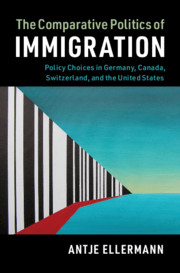 The Comparative Politics of Immigration
The Comparative Politics of Immigration Explaining Permanent and Temporary Economic Admissions
Published online by Cambridge University Press: 27 February 2021
This chapter lays out the making of Swiss economic immigration policy from the late 1940s to the mid-2010s. It begins with the establishment of Switzerland’s guest worker regime with the signing of the Swiss-Italian recruitment treaty in 1948. The second case study traces a series of regulatory reforms over the course of the 1960s, culminating in the creation of the global ceiling system in 1970. The chapter’s third case study is the Three Circles Policy which sought to reconcile the diplomatic imperative of free movement of European workers with the populist calls for closure. The chapter’s final case study examines policy making in the 2000s as the Swiss government opted for a treaty-based approach to market integration, followed by the 2008 immigration act which codified the policy changes enacted through bilateral treaties and executive directives over the previous years. In 2014, Swiss voters adopted the Mass Immigration Initiative which presented policy makers with the impossible choice between legislating the people’s will or maintaining its bilateral treaties with the European Union.
To save this book to your Kindle, first ensure [email protected] is added to your Approved Personal Document E-mail List under your Personal Document Settings on the Manage Your Content and Devices page of your Amazon account. Then enter the ‘name’ part of your Kindle email address below. Find out more about saving to your Kindle.
Note you can select to save to either the @free.kindle.com or @kindle.com variations. ‘@free.kindle.com’ emails are free but can only be saved to your device when it is connected to wi-fi. ‘@kindle.com’ emails can be delivered even when you are not connected to wi-fi, but note that service fees apply.
Find out more about the Kindle Personal Document Service.
To save content items to your account, please confirm that you agree to abide by our usage policies. If this is the first time you use this feature, you will be asked to authorise Cambridge Core to connect with your account. Find out more about saving content to Dropbox.
To save content items to your account, please confirm that you agree to abide by our usage policies. If this is the first time you use this feature, you will be asked to authorise Cambridge Core to connect with your account. Find out more about saving content to Google Drive.